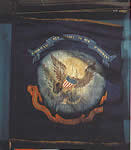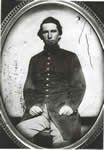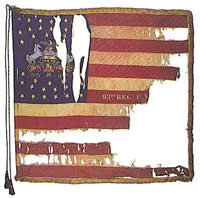 Open main menu
Open main menu
 Open main menu
Open main menu
Author and historian Timothy Reese, a noted authority on the Battle of Crampton's Gap, has consented to have AotW present here the principal content of his reference website, formerly hosted on Earthlink, now withdrawn from service. This page from that site features 3 of the key units at the Battle.
See also his main Crampton's Gap page.

Col. Alfred T.A. Torbert
(National Archives)
Premier among Union combat organizations at Crampton's Gap stands the First New Jersey Brigade commanded by Col. Alfred T.A. Torbert. The Jersey Brigade held left center of the Union line. The assault on Col. Thomas Munford's primary Confederate position was intended as a simultaneous attack all along the line of battle. Instead Torbert's brigade charged forward first, quickly dispersing Virginia infantry holding a thin line of defense in Mountain Church Road. Here the Jerseymen struck an empty void on the mountainside and kept going uphill until they reached the gap road, 1st and 3rd regiments in front, 2nd and 4th regiments close behind.
Reaching the road, Col. Henry Brown of the 3rd New Jersey sighted the flank of Gen. Howell Cobb's newly arrived support regiments just getting into place below him in the woods to his lower right. Brown wheeled his line on the road, coming down directly behind the Cobb Legion Infantry. Meanwhile the balance of Torbert's regiments inclined to their right, enveloping the Legion front and flank. Surrounded on three sides, the Legion line was nearly doubled back upon itself as it fought for survival. Within twenty minutes the Legion suffered 72 percent casualties, most accounted for as prisoners of war. Two stands of colors were captured.
Somewhat disarrayed, the 1st and 3rd sorted out their conquest while elements of the 2nd and 4th continued up the gap road where they assisted in reduction of Cobb's last stand in the gap. Soldiers of the 4th New Jersey were largely responsible for flanking the final Confederate position at twilight. Crampton's Gap had been won largely through the efforts of Torbert's unstoppable juggernaut.

Afterward Torbert was so pleased with the performance of the 4th Regiment that he petitioned the State of New Jersey to present new colors to the unit to replace those lost in action at Gaines' Mill in June of that year where the regiment had been surrounded and forced to surrender. Turn about had become fair play. This was a unique distinction because these new colors bore commemorative scrolls heralding gallantry at Crampton's Gap.
Early the following year Torbert also procured similar colors for his other three regiments, all in tribute to their performance that day. Though of like design, each regiment's new state flag bore a different central motif. That of the 4th New Jersey bore a full-color depiction of their charge up South Mountain. Hard field service and age have now made this painting wholly indiscernible. The brigade's subsequent field service unfolded beneath the memorable words "Crampton's Pass", benchmark for battles to come.

Lt. Col. Jefferson M. Lamar
(Courtesy Mrs. W. Elliott Dunwody, Jr.)
Contrary to popular misconception, the Cobb Georgia Legion was not raised by Gen. Howell Cobb, rather by his brother, Col. Thomas R.R. Cobb, later killed in action at Fredericksburg. A "legion" embodied elements of infantry, cavalry, and artillery. This system not lending itself to army organization, elements were distributed according to type, the Legion infantry battalion and Troup Light Artillery being assigned to Howell Cobb's brigade of McLaws' Division.
The great tragedy of Crampton's Gap is that Cobb's brigade was in the act of taking position above and behind Col. Thomas Munford's line of battle just as it gave way. Holding the extreme right, the Cobb Legion Infantry was quickly surrounded and nearly annihilated by the New Jersey Brigade. Within twenty minutes the Legion suffered 72 percent casualties, many taken as prisoners of war.
In this horrible predicament the Legion likely would have followed Munford's men in panicked retreat up the mountain. But its lieutenant colonel, Jefferson M. Lamar, held them to their impossible work until he had been twice shot, once mortally. By holding on to the last possible moment Lamar bought time for Howell Cobb to assemble a last-ditch stand in the gap, further forestalling Union penetration into Pleasant Valley where it would compromise Gen. Robert E. Lee's tenuous hold on South Mountain and with it the Confederate expedition into Maryland.

Cobb Legion flag
(GA State Museum)
At twilight a section (two guns) of the Troup Artillery hastily unlimbered in the gap crossroads and held back the Federal tide until it was too dark to pursue. Firing canister into the very faces our their adversary, Legion gunners incredibly held off massed assault largely on its own with remarkably few casualties. Then when all was obviously lost, the guns quickly limbered up and retired down the Harpers Ferry road to safety from whence they had come.
The Legion lost two colors through capture, most of its men being later exchanged for further field duty. Legion gunners were in the habit of naming their guns after wives and sweethearts. The 6-pounder "Sallie Craig" made good its escape, but the 12-pounder "Jennie" became disabled at the west foot of the mountain and had to be abandoned, claimed as a Union prize of war. It was hauled to the summit in triumph past the dead and wounded who had served her so well.
The 96th Pennsylvania Infantry of Schuylkill County made a singular impression at Crampton's' Gap. Largely composed of Anthracite coal miners under command of Col. Henry Cake, the regiment charged the extreme Confederate left, unsupported, driving the 10th Georgia of Semmes' Brigade from its Mountain Church Road defense line into a mountain meadow. In so doing they sparked one of the war's few recorded hand-to-hand bayonet fights. Driven headlong into the meadow, remnants of the 10th took shelter in the stone farm house of the widow Susan Tritt, converting it into an impenetrable fortification, their fire coming to bear from its windows. Undaunted the 96th surrounded the house, broke into it, and again cleared it with the bayonet.
Pushing on into the wooded mouth of Whipp's Ravine, Cake's 96th commenced the arduous ascent toward the gap only to again come under fire from the 15th North Carolina of Cobb's Brigade above them to their right on Arnoldstown Road. Cake turned the regiment to its right up the near vertical north face of the ravine, clawing their way toward their tormenter. In a twinkling the 96th fragmented the 15th North Carolina, a portion retreating into the gap, most scurrying up the mountain with Cake's nearly exhausted men right behind. At the summit of the north ridge winded prisoners gave themselves up, and the 96th's colors were planted in triumph after numerous color bearers had been shot from beneath them.

93rd PA flag
identical in pattern/maker
to that of 96th PA, now largely destroyed
Unparalleled by any other unit that day, the 96th Pennsylvania had charged and routed both primary and secondary Confederate battle lines unaided, clearing the way for Union forces to reach the gap through token resistance before confronting the Confederate last stand at the summit. In near total darkness the 96th retraced its steps to Arnoldstown Road where it encamped for the night, still somewhat removed from its parent brigade.
In a sense the regiment had fought its own battle on its own terms and had paid accordingly. 96th casualties were highest of any Union unit engaged at Crampton's Gap, 20 killed, 71 wounded. Only the maelstrom at Spottsylvania would claim a higher number from this regiment. If it can be said that the New Jersey Brigade crushed the Confederate right, then it can be truly said that the 96th Pennsylvania dispersed its left in vertical depth—all by itself. Their feats performed largely unseen in darkened woods, thanks were slow in coming. Several days later division commander Gen. Henry Slocum quietly offered Colonel Cake a congratulatory footnote: "Colonel, your coal-heavers did well!"
-- Timothy Reese, Burkittsville, Maryland
AotW Member
© 2000, Tim Reese
published online previously as part of the website at http://home.earthlink.net/~tjreesecg/index.html